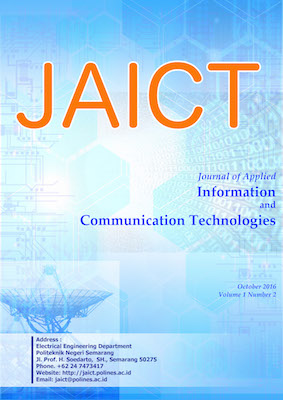Rice Plant Protection System Against Planthopper Pests By Utilizing Ultrasonic Waves Using Direct Digital Synthesizer
DOI:
https://doi.org/10.32497/jaict.v1i2.1345Keywords:
Direct Digital Synthesizer, DDS AD9850, Arduino, UltrasonicAbstract
-the largest pest Attacks against rice plant is pest. The most extermination of peasants is to use pesticides, but improper use of pesticides can thus cause a lot of losses. To overcome these physical methods used by utilizing ultrasonic wave with wave generator uses Direct Digital synthesizers. On the research of the testing was performed against the pest the pest by using frequency range audiosonik i.e. 1100 Hz ”“ 5000 Hz and ultrasonic range i.e. 20 KHz to 60 KHz.References
Bebet Nurbaeti, I. A. (2010). Hama Wereng Coklat (Nilaparvata lugens Stal) dan Pengendaliannya. Lembang: Balai Pengkajian Teknologi Pertanian Jawa Barat. [2] Agusdian, R., Frida, A.R., Widayanti. (2012). Sistem Proteksi Tanaman Padi dari Serangan Hama Wereng Menggunakan Gelombang Ultrasonik dan Penunjuk Arah Angin. Yogyakarta: Universitas Islam Negeri Sunan Kalijaga. [3] Tutik Nurhidayati, H. P. (2009). Rancang Bangun Alat Pengusir Hama Wereng Menggunakan Aplikasi Gelombang Ultrasonik. Diambil kembali dari Resits:http://resits.its.ac.id/index.php/journal/1- 42178/Rancang_Bangun_Alat_Pengusir_Hama_ Wereng_Menggunakan_Aplikasi_Gelombang_Ul trasonik (23 April 2017). [4] Baehaki. (1993). Berbagai Hama Serangga Tanaman Padi. Bandung: Angkasa. [5] Cheeke, J. D. (2002). Fundamentals And Applications Of Ultrasonic Waves. Florida: CRC Press LLC. [6] Phila Delpin, B. A. (2008). Rancang Bangun Alat Elektronik Pengusir Hama Tikus Pada Rumah Tangga. Makassar: Universitas Hasanuddin.
Devices, A. (1999). A Technical Tutorial on Digital Signal Synthesis. Analog Devices, IncDevices, A. (2009). Fundamentals of Direct Digital Synthesis (DDS). Analog Devices, Inc.
Downloads
Published
Issue
Section
License
Authors who publish with this journal agree to the following terms:Authors retain copyright and grant the journal right of first publication with the work simultaneously licensed under a Creative Commons Attribution License that allows others to share the work with an acknowledgement of the work's authorship and initial publication in this journal.
Authors are able to enter into separate, additional contractual arrangements for the non-exclusive distribution of the journal's published version of the work (e.g., post it to an institutional repository or publish it in a book), with an acknowledgement of its initial publication in this journal.
Authors are permitted and encouraged to post their work online (e.g., in institutional repositories or on their website) prior to and during the submission process, as it can lead to productive exchanges, as well as earlier and greater citation of published work (See The Effect of Open Access).






